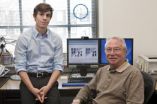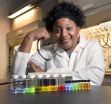(Press-News.org) The 25-story construction crane used since 1995 to investigate such things as how Pacific Northwest forests absorb carbon dioxide, obtain sufficient water and resist attacks by pests and diseases is being pruned back to just the tower.
The Wind River Canopy Crane, located in a 500-year-old forest near Stevenson in southwest Washington, has been operated cooperatively by the University of Washington, the Forest Service's Pacific Northwest Research Station and the Gifford Pinchot National Forest. The partners say the jib – the arm of the crane – is being removed because the Forest Service faces budget shortfalls and replacement parts for the crane are becoming more difficult to obtain. Funding for the crane's operation has largely come from the station's budget. The jib will be removed when money is available, possibly this summer.
Gone will be the ability to carry a gondola with researchers and instruments from the bottom to the top of trees as tall as 220 feet in a 560-foot circle of old-growth forest. The Wind River crane has the farthest reach of any of the nine forest canopy research cranes operating in the world today.
Remaining will be the 230-foot tower with sensors that collect data about how the carbon dioxide is absorbed and released by the forest, work under way since 1999. Because of the crane, the UW and the Forest Service have one of the world's longest, continuously collected data sets of carbon flux from a forest, according to Jerry Franklin, UW professor of forest resources, who was the prime mover in the 1990s for landing the $1 million project.
The carbon flux data are important as policymakers and citizens consider how to manage forests to maximize the amount of carbon they hold, he said.
Work at the crane site produced some of the first data to substantiate what Franklin and other scientists suspected in the 1980s: that old-growth Douglas fir forests weren't emitting more carbon than they were absorbing.
"Data collected at the crane site revealed that old growth forests are a sink for carbon," Franklin says.
A growing number of partners, ranging from the National Oceanic and Atmospheric Administration to the Smithsonian Institution Global Earth Observatories, count on carbon flux and isotope data being collected at the Wind River facility from the tower. Recently the site was chosen as the Pacific Northwest core site for the National Ecological Observatory Network, known as NEON, a major new initiative of the National Science Foundation.
The crane has facilitated other significant scientific discoveries, Franklin says, including seminal research on the structure of forest canopies, physiology of northwestern tree species, carbon and water cycles in forests, forest productivity and health, and the contributions of forest canopies to biodiversity, including birds, bats and insects. Researchers and students using the crane have generated more than 250 scientific publications.
The crane has, for example, enabled Pacific Northwest Research Station ecologist Rick Meinzer to study how very tall trees get the water they need to survive centuries of environmental extremes. During annual cycles of summer drought, trees rely on internal water storage to stabilize the supply of water to foliage high in the canopy, and on their deep roots to bring water close to the surface to feed shallow roots that might otherwise die every summer.
"Research using the crane has provided important insights about the factors that limit maximum tree height and why height growth slows drastically as a tree becomes taller," Meinzer says. "The tower will continue to be part of the nationwide network for continuous camera observation of changes in the timing of events such as leaf emergence and senescence, which are being influenced by climate change. Camera images are updated continuously and are available to both scientists and the public through websites."
The tower site and experimental forest also will continue to provide educational opportunities for high-school and college students focused on forest ecology, population dynamics and functions such as the cycling of carbon, water and nutrients.
INFORMATION:
For more information:
Franklin, jff@uw.edu
Meinzer, 541-758-7798, fmeinzer@fs.fed.us
Additional images available, see link below and request higher resolution versions from Sandra Hines:
http://www.washington.edu/news/articles/era-of-canopy-crane-ending-certain-research-and-education-activities-remain
Suggested links
Crane homepage
http://depts.washington.edu/wrccrf/
Crane details
http://depts.washington.edu/wrccrf/crane.html
List of publications from crane research
http://depts.washington.edu/wrccrf/docs/WRCCRFPubList.html
UW School of Forest Resources
http://www.cfr.washington.edu/
Forest Service's Pacific Northwest Research Station
http://www.fs.fed.us/pnw/
Gifford Pinchot National Forest
http://tinyurl.com/GiffordPinchot
NEON, National Ecological Observatory Network
http://www.neoninc.org/
Jerry Franklin
http://faculty.washington.edu/jff/
Rick Meinzer
http://www.fs.fed.us/pnw/about/programs/ecop/canopy.shtml
Sampling of findings, opportunities:
Scientists interested in comparing the canopies of young and old-growth Douglas fir forests used the crane to document how completely different the structure – or architecture – of the older forest is.
The complexity of older canopies – with branches and foliage from the bottom to the top of trees – is one reason older forests are good at taking up carbon dioxide, research at the crane showed. There's a lot more "leaf area" than in younger forests where foliage is mainly at the tops of trees.
Research at the crane has revealed some of the ecosystem advantages of complex forest canopies and insight into how younger forests might be managed for more complexity if we wish.
As to the puzzle of how old growth Douglas firs can thrive for centuries after they stop growing taller and their crowns stop getting fuller, work at the crane was the first to definitively show that old trees generate new growth from dormant buds on their lower branches. It's more proof of the active growing in stands once considered to be in a state of decay.
The crane has provided educational opportunities for thousands of college students, teachers and natural resource professionals. At the secondary level, among other things, the crane was part of a television broadcast that reached 7 million students in North America.
The crane is located in the Wind River Experimental Forest of the Gifford National Forests where for nearly 100 years studies have been conducted into nursery practices, seedling survival and growth, genetics and ecology.
Era of canopy crane ending; certain research and education activities remain
2011-04-29
ELSE PRESS RELEASES FROM THIS DATE:
Pediatric flu vaccination: Understanding low acceptance rates could help increase coverage
2011-04-29
A study of H1N1 and seasonal influenza vaccination in a sample of black and Hispanic children in Atlanta found a low rate of vaccine acceptance among parents and caregivers. Only 36 percent of parents and caregivers indicated they would immunize children against H1N1, and 22 percent indicated their children received the seasonal influenza vaccine in the previous three months. The majority of children in the sample (71 percent) were from households with less than $40,000 in annual income.
Researchers say this low level of vaccine coverage and acceptance highlights the ...
As the worm turns, its secrets are revealed
2011-04-29
An international team of scientists, led by researchers at the University of California, San Diego School of Medicine, have developed a new method for discerning the functions of previously uncharacterized genes and placing them in interactive, functional networks that reveal how gene products interact to bring about cellular events.
The research is published in the April 29 issue of the journal Cell. It was led by principal investigators Karen Oegema, PhD, professor of cellular and molecular medicine and head of the Laboratory of Mitotic Mechanisms in the Ludwig Institute ...
From the beginning, the brain knows the difference between night and day
2011-04-29
The brain is apparently programmed from birth to develop the ability to determine sunrise and sunset, new research on circadian rhythms at the University of Chicago shows.
The research sheds new light on brain plasticity and may explain some basic human behaviors, according to Brian Prendergast, associate professor in psychology at the University of Chicago and co-author of a paper published April 27 in the journal PLoS One. The lead author is August Kampf-Lassin, an advanced graduate student at the University.
"This finding may show us why infants of many species eventually ...
Get The Labels You Adore For Prices You Love at TK Maxx Crewe
2011-04-29
The long-awaited TK Maxx store is nearly ready to open its doors at the Grand Junction Retail Park, Crewe. This new store is set to open on Thursday 28 April at 9am and will feature nearly 20,000 sq ft of famous label fashion, shoes and accessories for men and women plus homewares, kids and toys - all at up to 60% off the RRP.
The first lucky 500 customers through the doors at 9am will be treated to a GBP10 gift card to spend in the new store.
The TK Maxx concept is simple. TK Maxx buyers shop the world all year round working direct with designers and negotiating ...
Study: Cotton swabs prove problematic for ear health
2011-04-29
DETROIT – A study by Henry Ford Hospital shows a direct association between cotton swab use and ruptured eardrum.
The study also shows that in most cases the rupture heals on its own and surgery is only necessary for the most severe cases.
"In the past, many otolaryngologists have wondered if surgery is really necessary to treat a ruptured eardrum. The results of this study show that 97 percent of cases healed on their own within two months, proving that most cases do not require surgery," says Ilaaf Darrat, M.D., an otolaryngologist at Henry Ford Hospital and co-author ...
Louisiana Tech researcher presents on eco-friendly nanotechnology at national conference
2011-04-29
RUSTON, La. – Dr. Yuri Lvov, professor of chemistry and T.C. Pipes endowed chair in micro and nanosystems at Louisiana Tech University, recently led a symposium at the 241st Conference of the American Chemical Society (ACS), discussing his application of a more eco-friendly and cost-effective nano-material that can be used to significantly improve the properties of plastics, paints and other synthetic composites.
The symposium featured Lvov's presentation on the use of clay "nanotubes" – created from dirt and soils found in a number of places on earth – to strengthen ...
Prejudice and the President
2011-04-29
Racial prejudice among some white Americans—even if unintentional—influences their views of President Barack Obama's "Americanism" and their assessment of how well he is performing in office, according to a University of Delaware doctoral student.
The psychology student, Eric Hehman, recently received the national Albert Bandura Graduate Research Award for his paper detailing a research study he conducted on the subject. The article, "Evaluations of Presidential Performance: Race, Prejudice, and Perceptions of Americanism," was published in the March issue of the Journal ...
Headwater - A Taste of Puglia- For Free!
2011-04-29
Firmly tucked away on the spur of Italy's heel, the dramatic coastline of Puglia is one of the country's best-kept secrets. It's a sun-soaked land of rolling vineyards, historic hamlets, colourful fishing villages and wonderfully deserted white beaches stretching as far as the eye can see.
Cycling in Puglia with Headwater allows you to explore at leisure, stopping off as the mood takes you, to enjoy long lazy lunches in pretty white villages or relaxing dips in the clear emerald seas of the Adriatic.
You'll eat well here too. Traditional Puglian cuisine uses the freshest ...
"Married Filing Jointly" is Not Always The Best Option
2011-04-29
"Married Filing Jointly" is Not Always The Best Option
Most tax professionals would agree that "married filing jointly" is generally the most advantageous filing status. Spouses' incomes are combined, deductable expenses are pooled together and there are some benefits that are available only to joint filers.
While a joint return is typically how married couples file, what if you had recently become suspicious of your spouse and the source some of his or her income? What if your spouse had been making millions or even billions from a Ponzi scheme ...
Iowa State chemist designs new polymer structures for use as 'plastic electronics'
2011-04-29
AMES, Iowa – Iowa State University's Malika Jeffries-EL says she's studying doing structure-property studies so she can teach old polymers new tricks.
Those tricks improve the properties of certain organic polymers that mimic the properties of traditional inorganic semiconductors and could make the polymers very useful in organic solar cells, light-emitting diodes and thin-film transistors.
Conductive polymers date back to the late 1970s when researchers Alan Heeger, Alan MacDiarmid and Hideki Shirakawa discovered that plastics, with certain arrangements of atoms, can ...



